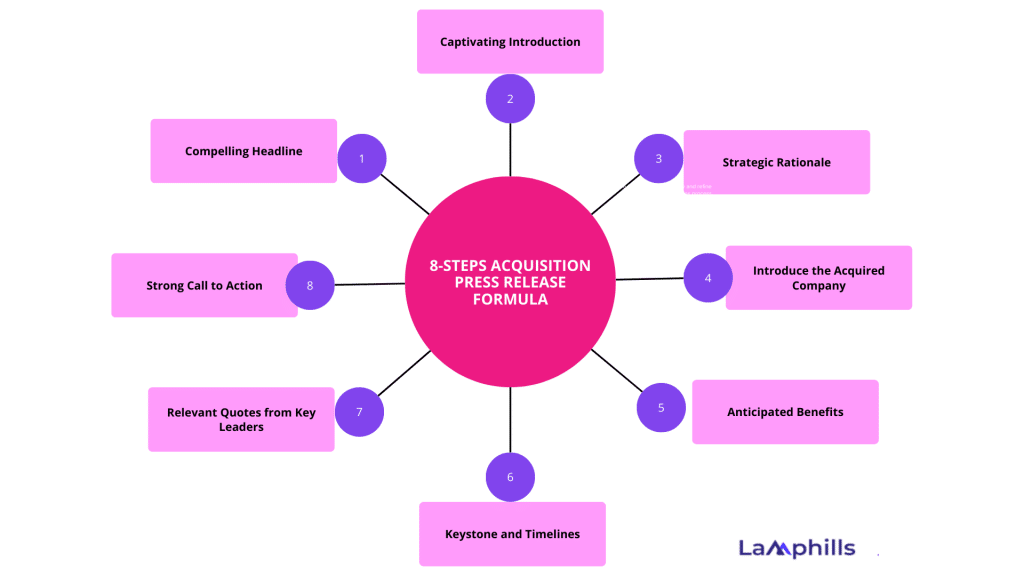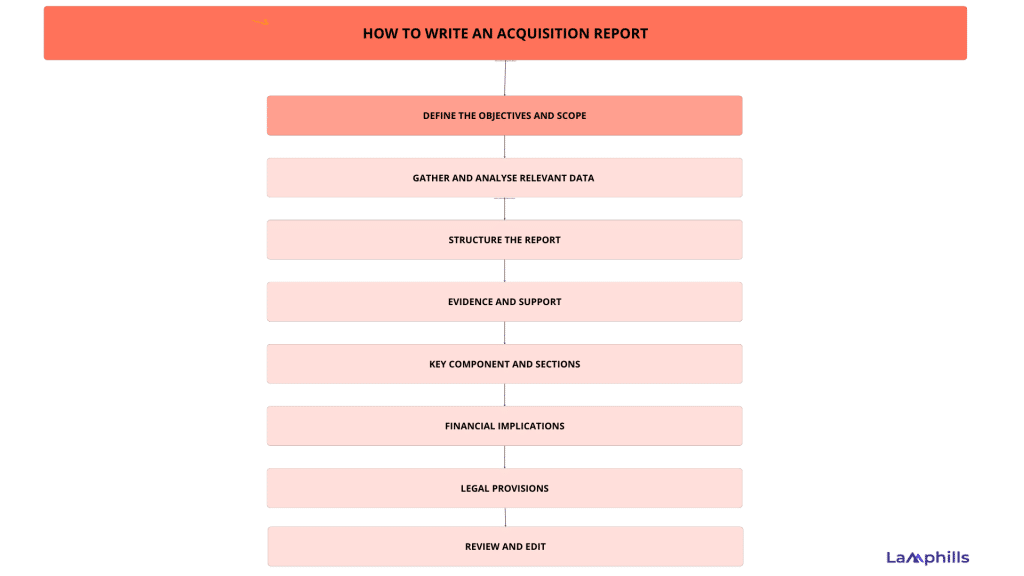Do you remember how strange you felt when you eventually signed your ideal client? The happy moment and celebration are all part of an unforgettable moment. But in all the enthusiasm, have you thought about how you might use this victory to attract even more customers? Having spent years navigating the world of acquisition news releases, I can attest that there is a strategic formula that distinguishes the good from the extraordinary. In this article, I will be sharing with you the 8-Step Acquisition Press Release Formula that has proven to be effective.
Key Points
- An acquisition press release serves as an official declaration that one business is purchasing another, demonstrating development and expansion which typically includes elements like a compelling headline and strategic rationale amongst others.
- A primary distinction is that press releases are promotional in nature, aimed at journalists, and incorporate narrative components. News releases may be distributed to a larger audience, objectively convey factual information, and prioritize information delivery over advertising.
- Writing an interesting acquisition press release requires using storytelling strategies that highlight the companies involved, the acquisition’s background, the benefits to the audience, leadership quotes, and a clear call to action at the end.
What is an Acquisition Press Release?
An acquisition press release is a statement that a company issues to announce that they have acquired another company. It’s like a fancy way of saying, “Hey, I bought these cool folks over here!” It’s a way for the company to share the big news with the world and showcase its growth and expansion.
8-Step Acquisition Press Release Formula

Now, when it comes to the content of an acquisition press release, there are a few key steps that are usually needed to serve as a guide. They are:
#1. Compelling Headline
This is like the title of a story; it should be catchy and draw people in. Think of it as the first impression that sets the tone for the announcement. For example, having “Man City, on Sale” on the front cover of a headline can mean different things as well as create an attraction for football lovers all over the world.
#2. Captivating Introduction
Just like a good conversation starter, this part should captivate the audience’s interest from the get-go. It’s where you lay the foundation for what’s to come. Starting the page with an interesting storyline.
#3. Highlighting the Strategic Rationale
Here, you explain the “why” behind the acquisition. It’s like sharing the big-picture strategy that led to this decision. Using the above illustration of a football news. You could start with a phrase like, “Being the emerging title cup winner, Man City management, backed up by EPL has been endorsed to host the Next World Cup and to facilitate a bigger and more effective preparation. They have decided to partner with Arsenal under the directive of Arteta as the Chairperson.”
#4. Introducing the Acquired Company
This step is about introducing the company being acquired. It’s like presenting a new character in a story, giving background and context. Giving a rundown of details about this company could also play a significant role, especially adding the value created.
#5. Discussing the Anticipated Benefits
Imagine this as the part where you talk about the positive outcomes expected from the acquisition. It’s like painting a picture of the future. It is like upholding the vision and plan set in place to be achieved.
#6. Highlighting Key Milestones and Timeline
This is where you outline the important events and the timeline for the acquisition. It’s like mapping out the journey ahead. An example could be, a place where the final engagement will be held to help the press validate their questions.
#7. Including Relevant Quotes from Key Leaders
Adding quotes from key figures humanizes the announcement. It’s like giving a voice to the people behind the decision, adding credibility and personality. This gives the audience a level of conviction and insight into the purpose of the acquisition.
#8. Closing with a Strong Call-to-Action
Similar to a conclusion in a story, this is where I advise you to wrap everything up and encourage the audience to take action. It’s like leaving them with a clear next step or a final thought.
Each step plays a crucial role in crafting a successful acquisition announcement, guiding the audience through a well-structured narrative that informs, engages, and motivates.
Acquisition Press Release Examples
Okay, let’s take a look at some acquisition press release examples that showcase the reasons behind the acquisition and how it benefits both companies.
Example 1:
InterGlobe Acquires Trailblazing AI Startup, Accelerating its Transformation into an AI-Powered Industry Leader
“As the Chief Innovation Officer at InterGlobe, I’m thrilled to announce our acquisition of ABC, a pioneering AI startup that has been making waves in our industry. This acquisition is a pivotal moment in Interglobe’s journey, as we double down on our commitment to become the leading AI-powered solution for our customers.”
Example 2:
Chennai Corp Acquires Industry Leader XYZ, Solidifying its Position as the Go-To Solution for Sustainable Manufacturing.
“As the CEO of Chennai Corp, I’m thrilled to announce our acquisition of industry leader XYZ. This strategic move is a game-changer for our company and the manufacturing sector as a whole. For years, we’ve been on a mission to revolutionize the way businesses approach sustainability. With XYZ’s cutting-edge technology and deep domain expertise now under our roof, we’re poised to take this mission to the next level.”
So, the next time you’re tasked with crafting an acquisition press release, remember to unleash your brand’s unique voice, showcase your deep industry expertise, and paint a vivid picture of the exciting future that lies ahead. After all, a well-executed acquisition press release can be the key to unlocking your business’s next chapter of growth and success.

How to Write an Acquisition Press Release
Let’s face it, press releases can be about as exciting as watching paint dry. But hey, when you’ve just landed a killer acquisition, you want to shout it from the rooftops, right? The good news is that an acquisition press release can be a powerful tool to attract new clients and generate buzz. The key? Ditch the robotic tone and craft a narrative that’s both informative and engaging.
Download Lamphills Free Template Here
Remember, this template is just a starting point. The true power of your acquisition press release lies in your ability to infuse it with your unique brand voice, industry expertise, and customer-centric approach. By doing so, you’ll create a compelling narrative that resonates with your target audience and positions your business as a trusted authority in your space.
Here’s double double-checked plan for writing an acquisition press release that’ll have everyone hooked to you.
#1. Captivate With your Headline

Think of your headline as the flashing neon sign outside your grand opening. It needs to be clear, concise, and grab attention. Use something more catchy like “[Acquiring Company Name] Strengthens Market Position with Acquisition of [Acquired Company Name]”. Instead of just “Acquisition Announcement”.
#2. Story Lead
The first paragraph is your chance to set the stage and tell the story of the acquisition. For example, instead of a dry “We are pleased to announce…”, try something like “We’re thrilled to share some groundbreaking news! Today, [Acquiring Company Name] is proud to announce the acquisition of the innovative team at [Acquired Company Name].”
#3. Company Backgrounders
Think of this as the “meet the characters” section. Briefly introduce both companies, but focus on the good stuff – their strengths, accomplishments, and what makes them special. Keep it concise, but paint a picture of why this acquisition is a big deal.
#4. Acquisition Benefit to Your Audience
This is where you shift the spotlight to your audience. Explain how this acquisition benefits them – the future customers you’re trying to win over. Are there new products or services on the horizon? Enhanced expertise that translates into better results? Focus on the positive impact on your target audience. Paint a clear picture of how their lives (or businesses) will be improved by this strategic move.
#5. Executive Quotes
People love a good story, and who better to tell it than the key players involved in the acquisition? Quotes from CEOs or company leaders add a personal touch and lend credibility to the announcement. Keep it enthusiastic and forward-looking.
#6. Call to Action
Don’t just drop the mic and walk off stage. Tell your audience what you want them to do next! Is it visiting your website to learn more about a specific product or service? Contacting your sales team to discuss potential partnerships? Provide a clear call to action that keeps the momentum going.
#7. Visual Appeal Matters
Let’s be honest, a wall of text is enough to make anyone’s eyes glaze over. Break up the monotony with some visuals! Include high-quality logos, product images, or even a short video that showcases the combined strengths of both companies.
#8. Contact Information
Think of this as your “open door” policy. Make it easy for journalists and potential clients to get in touch. Include clear and accurate contact details for your media representative.
By following these steps and weaving in storytelling elements, you can craft an acquisition press release that’s both informative and captivating. Remember, a press release template can be a helpful tool to keep you organized but don’t let it stifle your creativity. Infuse your announcement with your brand’s unique personality and the specific details of your acquisition. After all, who says press releases can’t be exciting?
How to Summarize an Acquisition?
Have you ever tried writing a company acquisition report but it left you confused because you are struggling to understand and choose terms and terminologies to use? “Market synergies,” “strategic fit,” and “integration plans” – enough to make your head spin! Be calm, need not worry— I’m going to show you how to summarize acquisition and still maintain originality.
Summarizing an acquisition can be an exciting and transformative process for any company involved. It’s like two puzzle pieces coming together to create something greater than the sum of its parts. Here are some steps to help you effectively summarize an acquisition:
- Introduce the companies: Start by introducing the companies involved in the acquisition, highlighting their respective strengths, and what they bring to the table. This sets the stage for the significance of the acquisition.
- Explain the purpose: Share the rationale behind the acquisition. Is it to expand into new markets, leverage synergies, or enhance capabilities? This helps readers understand the strategic thinking behind the decision.
- Highlight the benefits: Emphasize the benefits that the acquisition brings to both companies involved. This could include increased market share, access to new technologies or resources, expanded customer base, or improved operational efficiencies. Paint a picture of the exciting possibilities that lie ahead.
Also Read: My Most Effective News Release Templates for the Best Results
- Discuss integration plans: Talk about the integration plans and how the companies will come together. Will there be a blending of cultures, sharing of best practices, or consolidation of operations? Addressing these aspects helps create a sense of unity and collaboration.
- Address customer impact: Acknowledge the impact on customers and assure them that the acquisition will enhance their experience. Reassure them that products or services will continue to be delivered with the same level of quality and perhaps even improved through the combined expertise of the companies.
- Recognize the teams: Show appreciation for the teams involved in making the acquisition a reality. Recognize their hard work, dedication, and vision. Highlight the value of their skills and expertise in driving the success of the acquisition.
- Look to the future: Conclude by expressing optimism for the future, illustrating how the acquisition positions the company for growth, innovation, and continued success. Share the vision for what the newly formed entity aims to achieve.
Summarizing an acquisition is an opportunity to showcase the excitement and potential that comes with two companies joining forces.
You Can Get Lamphills Acquisition Press Release Template Here: Download for Free
How to Write an Acquisition Report?
An acquisition report is a type of report that provides insights into how users arrive at a website or app. It helps track and analyze the sources and mediums through which visitors are acquired, as well as their behavior and conversion patterns.
Key features include tracking traffic sources, mediums, behavior and conversion, and campaign tracking. By analyzing the data, businesses can identify successful traffic sources, evaluate campaign performance, optimize user experience, and track the impact of various marketing channels on overall website traffic and conversions.

Writing an acquisition report involves several key steps and considerations. Here is a general guide to help you write an effective acquisition report:
#1. Define the Objectives and Scope
Clearly define the objectives and scope of the acquisition report. This includes identifying the purpose of the report, the specific areas to be covered, and the target audience. Defining the objectives and scope provides a clear direction for the report.
#2. Gather and Analyze Relevant Data
Gathering and analyzing relevant data is a crucial part of writing an acquisition report. Ensure that the data used is reliable, and accurate, and supports your claims and recommendations.
#3. Structure the Report
Organize the report into sections and subsections to enhance readability and clarity. Common sections in an acquisition report may include an executive summary, introduction, methodology, findings, analysis, conclusions, and recommendations. Each section should be clearly labelled and address specific aspects of the acquisition.
#4. Provide Evidence and Support
When writing an acquisition report, it is important to provide evidence and support for your claims and arguments. Cite all the sources used to gather and analyze the data for your report, not just the ones directly quoted or paraphrased. This helps establish credibility and allows readers to verify the information.
#5. Include Key Components and Sections
Ensure that your acquisition report includes key components and sections that are relevant to the objectives and scope. These may include an overview of the acquisition process, analysis of financial data, assessment of risks and opportunities, evaluation of synergies, and recommendations for future actions.
#6. Include Financial Implications
Present the financial aspects of the acquisition, such as the purchase price, expected synergies, and potential cost savings. Use simple language and visual aids, such as graphs or charts, to make the information more accessible and understandable.
#7. Include Legal Provisions
Incorporate legal clauses like severability, amendment, governing law, and confidentiality agreements to protect both parties’ interests and ensure a smooth acquisition process.
#8. Review and Edit
Before finalizing the acquisition report, review and edit it for clarity, coherence, and accuracy. Check for any grammatical or spelling errors and ensure that the report flows logically from one section to another.
However, the specific structure and content of an acquisition report may vary depending on the context and requirements. Always tailor the report to the needs of your organization and audience.
What is the Difference Between a News Release and a Press Release?
The terms “press release” and “news release” are often used interchangeably, and there isn’t always a huge distinction. However, some subtle differences can exist depending on the source and purpose. Here’s a breakdown:
Target Audience:
- Press Release: Primarily targets journalists and media outlets. The goal is to capture their attention and encourage them to cover the news of the acquisition in their publications.
- News Release: May have a broader audience in mind. It can be aimed at journalists, but also stakeholders, customers, the general public, or anyone with an interest in the organization.
Content and Tone:
- Press Release: Often more promotional in nature, highlighting the positive aspects of the acquisition and its benefits for the acquiring company. It might include elements of storytelling and branding, along with quotes from company executives.
- News Release: Focuses on factual information about the acquisition. It presents the who, what, when, and why of the situation in a neutral and objective tone.
In essence, both press releases and news releases announce information, but the press release tends to be more promotional and targeted towards media coverage, while the news release can be more broadly informative.
Conclusion
In summary, we need to understand that the true power of your acquisition press release lies in your ability to infuse it with your unique brand voice, industry expertise, and customer-centric approach. By doing so, you’ll create a compelling narrative that resonates with your target audience and positions your business as a trusted authority in your space. What often comes to our mind is: How do you successfully create a captivating headline that doesn’t jeopardize the acquisition? What is the best time to send a Press Release? Let us hear your view from the comment section.
Related Article
- Press Release Boilerplate: Writing An Effective Copy
- My Most Effective News Release Templates for the Best Results
- PR Strategy: The Most Effective Strategies in 2024 (+ Expert Tips)
- 21 Event Press Release Templates & Examples That Inspires Me





